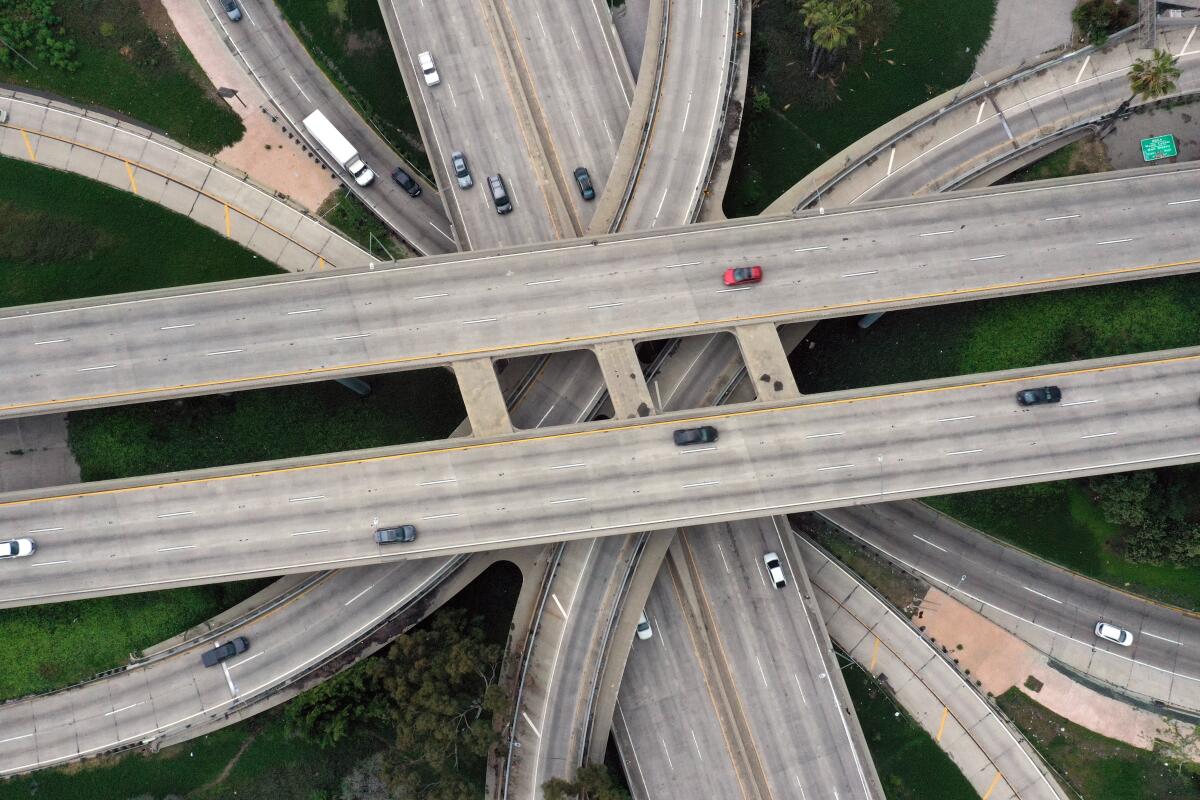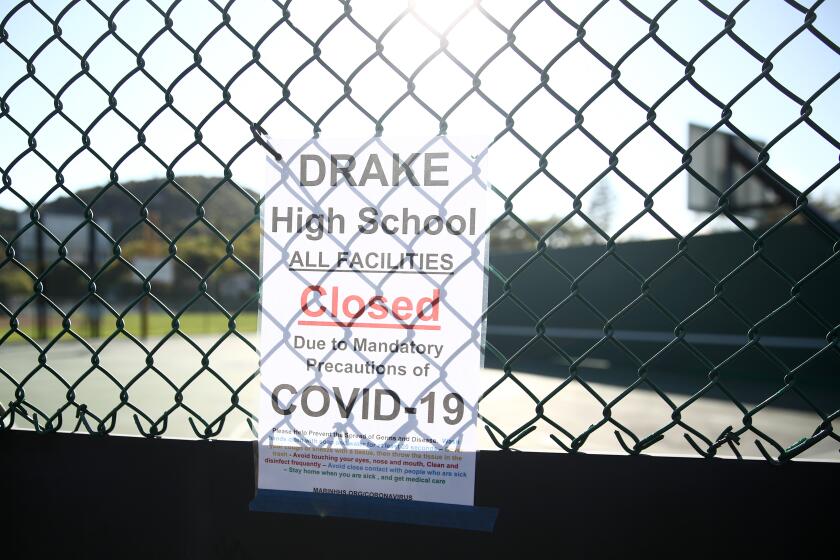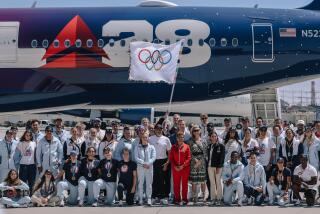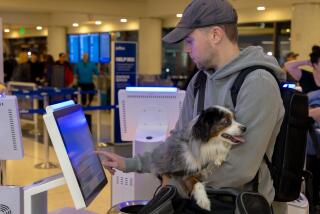Opinion: Coronavirus shutdowns are making it undeniably clear how toxic our car culture is

On April 3, residents of the Indian city of Jalandhar saw something they hadn’t in at least 40 years: the spectacular snow-capped peaks of the Himalayas walling off the far eastern outskirts of their city.
Halfway around the world, at roughly the same time, I had the similar (admittedly less dramatic) experience of looking out the window of my Los Angeles home and seeing, for the first time, the most beautiful mountain in Southern California — San Jacinto — staring back at me from 100 miles away.
These auspicious vistas on opposite sides of the planet were obviously not coincidental. Air pollution in cities across the globe has plummeted as coronavirus shutdowns have kept businesses closed and most of us indoors under stay-at-home orders. Though ruinous economically, these shutdowns are producing some environmental miracles that have been impossible not to notice.
On the macro level, carbon emissions are likely dropping (we won’t know to what extent for months). But the localized effect on city air quality has been obvious, visible and profound.
Less than a year ago, satellite data revealed Los Angeles’ notoriously dirty air was even filthier than was previously realized. Now, under Mayor Eric Garcetti’s “safer at home” order, the city has some of the cleanest air of any major urban population center in the world. And we can literally see, smell and even taste the difference.
We’re all stuck inside under coronavirus quarantine. Are we at least preventing climate change? Not really.
So how did we get here? Coronavirus lockdowns, sure. But, to be clear, we’re still burning fossil fuels to power our homes. Many businesses are shut, but essential heavy industries are still up and running. Supply trucks are still delivering goods for us to buy.
The difference is cars. Or lack thereof. Trapped indoors, people are no longer driving their cars anywhere and everywhere.
Our newly car-lite streets aren’t just making for lovely mountain vistas and pleasant evening strolls (although those are certainly welcome), they’re saving lives. Air pollution kills — to the tune of 7 million people each year around the world, mostly from the burning of fossil fuels. Coal-fired power plants do much of that damage, sure, but automobiles do too. In L.A. alone — which has more than 7 million cars in the region and zero coal plants — more than 1,300 people die each year from dirty air. And those numbers have been steadily rising since 2010, despite Obama-era clean car regulations.
Pollution deaths are almost never equally distributed. In Los Angeles, poor communities of color suffer most — thanks to the legacy of segregation and racially-motivated freeway construction through these neighborhoods. Children directly exposed to this pollution are subject to higher rates of asthma and unnatural cognitive decline.
And then there are the crashes. A UC Davis study recently found that lockdown orders had prevented 6,000 serious injuries and deaths on California roads — and saved over $1 billion in crash-related costs.
Sixty percent of all car trips taken in the U.S. are under 6 miles. But dangerous car-centric streets deter people from bicycling or walking — creating a vicious cycle where we all drive everywhere.
Scientists are starting to ask whether, under lockdown, fewer people will die from the coronavirus than would have otherwise been killed by vehicle-related causes.
The coronavirus is making it abundantly clear that cars are their own kind of plague. And, in many ways, our lives are better when we don’t have to use them.
Some city leaders have come to this realization and are refusing to allow their automotive status quos to return after the lockdowns end. In Milan, Italy — one of the hardest-hit cities in the world by coronavirus — planners have already begun preparations to permanently transform 22 miles of streets for non-automobile use after witnessing reductions in air pollution of up to 70% during lockdowns.
Milan deputy mayor Marco Granelli told the Guardian these street redesigns aren’t just in the name of environmentalism, they’re an integral part of the city’s coronavirus economic recovery plans: “We worked for years to reduce car use. If everybody drives a car, there is no space for people, there is no space to move, there is no space for commercial activities outside the shops.”
New York, meanwhile, legalized the use of electric bikes and scooters, the preferred transportation method for underpaid delivery workers.
Public transit use skyrocketed after the 2008 financial crisis. There’s a reason: Driving is expensive. Americans are facing an unemployment wave that might surpass the Great Depression. Less than half of L.A. County residents have jobs right now. Workers need cheap, safe ways to get around that won’t kill them or the people around them.
For that reason and others, electric cars are not the panacea they’re made out to be. Putting aside the obvious expense, actually producing enough green energy to put a dent in air pollution, zero out emissions and slow climate change requires a renewable energy capacity we’re not close to achieving. Nor will EVs stop localized transportation pollution. Particulates from car tires fly into the air and settle in our lungs and our water and food supplies. Brake dust too.
Frankly, the idea that we can transport ourselves sustainably en masse in toxic 4,000-pound battering rams is just as delusional, entitled and self-destructive as the “liberate” protestors who are demanding a premature end to coronavirus-related stay-at-home orders.
When the world emerges from its lockdown, the temptation will be to jump right back into our hermetically sealed transport bubbles. So, while you still can, step outside. Take a breath of fresh air. Take a quiet walk in the street. Or a bike ride with your kids. And think about how nice it would be to have clean air and safe streets as our new normal.
There is no herd immunity from the damage caused by millions of personal automobiles roaming the streets at all hours.
More to Read
A cure for the common opinion
Get thought-provoking perspectives with our weekly newsletter.
You may occasionally receive promotional content from the Los Angeles Times.












